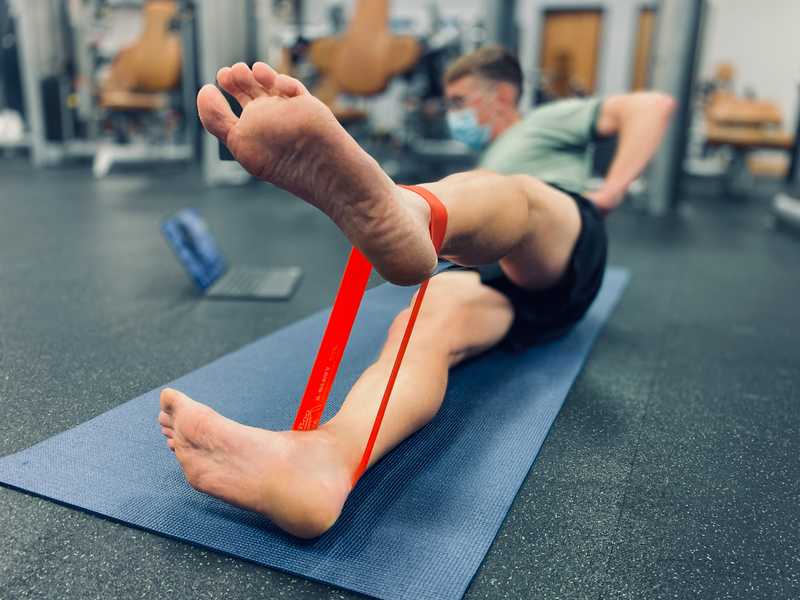People are increasingly seeking physical therapy treatments that is easy, safe, and secure. Virtual physical therapy from CityPT is exactly that. And, if you're wondering how you can be treated without being touched, scientific evidence shows that virtual physical therapy is as effective as in-person therapy.
While virtual physical therapy does not completely replace in-person services, it can be an essential component of an effective physical therapy care plan.
So, what are the advantages of virtual physical therapy, and how can you benefit? Keep reading to learn the evidence.
Table of Contents
- What is Virtual Physical Therapy?
- Does virtual physical therapy really work?
- Research Supports Virtual Physical Therapy
- Advantages of Virtual Physical Therapy
- Virtual Physical Therapy Complements In-Person Therapy
- Physical Therapists Provide Patient Accountability with Technology
- Tailoring Treatment for Each Patient's Needs
- The Consensus: Virtual Physical Therapy Is Effective
- Who Can Benefit from Virtual PT?
- What to Expect from a Virtual Physical Therapy Session
- What You Need for Virtual Physical Therapy
- How to Make the Most of Your Online PT Session
- CityPT: We Excel at Virtual Physical Therapy
What is Virtual Physical Therapy?
Virtual physical therapy is also known as telehealth physical therapy, remote physical therapy, telerehab, teletherapy and telemedicine physical therapy. The coronavirus pandemic accelerated the use of telehealth for physical therapy across the country for all types of diagnoses and age groups.
The American Physical Therapy Association (APTA) defines telehealth physical therapy as "the use of electronic information and telecommunication technologies to remotely provide health care information and services."1 Technology supporting telehealth has rapidly adapted to the increasing demand for virtual physical therapy services during the coronavirus pandemic. As a result, patients are accustomed to receiving physical therapy using virtual methods and the evidence supporting the efficacy of telehealth physical therapy has grown rapidly.
With greater numbers of people enrolled in virtual physical therapy, there are now more data to answer the question on many patients' minds:
Does virtual physical therapy really work?
Telehealth physical therapy has been around for decades. In recent years, the APTA gave support to telehealth physical therapy as a way to provide clinical services, educate patients, monitor progress, and encourage patient engagement.
Prior to the pandemic, few studies were able to look at the effectiveness and safety of virtual physical therapy due to slow adoption of telehealth. But improved technology and the increased demand related to Covid has given us a better picture of how well virtual physical therapy really works.
Research Supports Virtual Physical Therapy
FAIR Health, a database of private and government insurance claims, reported the demand for telehealth increased by 25,000% between 2019 and 2020.2 The same study showed that the greatest increase of telehealth involved relief for soft tissue (such as muscles) and joint injuries.
Top Evidence-Based Benefits
The data provides a wealth of evidence supporting the efficacy of telehealth physical therapy, including:
- Patients were happy: Patient satisfaction rates matched virtual and in-person physical therapy services. Moreover, survey results showed higher satisfaction rates for telehealth physical therapy for scheduling appointments and individualized time with the therapist as compared to in-person visits.3
- Technology provides accurate feedback: Health information technology, such as wearables, activity trackers, and electronic medical records that collect real-time data of telehealth physical therapy visits provide the most accurate feedback of patient progress information to PT providers.4
- Outcomes were similar to in-person visits: Virtual physical therapy, delivered using real-time electronic communication technology, is as effective as in-person physical therapy for treating musculoskeletal conditions.5
- Effectively Treats A Variety of Problems: Telehealth physical therapy is effective in treating pain, improving movement and strength, and facilitating patients' adherence to exercise programs.6
Advantages of Virtual Physical Therapy
Virtual physical therapy, telehealth physical therapy, or telerehab comes in a variety of forms.
Patients can engage through:
- Live audio and video using a software platform, such as Zoom or Skype
- Telephony with a provider if leveraging TTY support
- Textual exchanges using email, text messaging, or communicating through a patient portal
The evidence clearly supports virtual PT as an excellent way to address injuries and promote optimal health. Let's dive into some of the major benefits that a patient can gain when utilizing online PT treatment.
1. Virtual Physical Therapy Optimizes Time
Implementation of virtual physical therapy is flexible and continues to evolve as new technology makes it even easier to connect with the right physical therapist.
Virtual physical therapy recognizes that patient care is not limited to time during a session. Instead, good care reflects ongoing communication to support new ways of living with evolving conditions.
This is where virtual PT truly has the upper hand. Quality time can be spent between the therapist and client without worries about a commute. With CityPT Virtual PT, you also won't be subject to crowded clinics, or therapists that are distracted by multiple patients at the same time as you.
Additionally, access to care typically doesn't involve a lag like it often does with traditional PT clinics.
We discuss this further in our article about the benefits of cash-based PT.
2. Virtual PT is Not Limited by Scheduled Visits
Patients may have questions or feedback outside of the visit. These questions can be answered quickly and effectively using flexible communication methods such as phone, text, or client portal.
Flexible use of all virtual physical therapy communication methods allows patients to communicate with their therapist, complete surveys, and watch home exercise videos carefully selected by providers. This can vastly improve patient outcomes with they get immediate feedback rather than waiting for their scheduled visits.
3. Accessibility to Care for Rural Areas
Virtual physical therapy opens new possibilities for patients living far away from provider centers. About 60 million Americans live in rural areas with limited access to care. And, in the past year, rural America has grown, which brings an increased need for accessible services for remote communities.
Telehealth helps bridge the gap between specialist physical therapy providers such as lymphedema management and vestibular rehabilitation and folks who normally would not have access to advanced healthcare.
4. Accessibility to Treatment for Busy Lives
Virtual physical therapy also offers extra convenience. Patients with children, full-time employment, and competing priorities have an easier time fitting virtual physical therapy into their agenda.
Virtual physical therapy eliminates the commute, search for parking, sitting in a waiting room, and other barriers associated with in-person visits. Since time is often a major barrier to getting much needed PT treatment, virtual PT can help immensely.
5. Providing Relevant Treatment and Feedback
When patients are treated virtually in their own environment, the physical therapist can observe and advise on adaptations to the home or office to improve progress.
Personalized recommendations and real-time feedback can help therapists and patients focus on specific pain points in their home environments. This helps reduce any overlooked issues that may be limiting recovery.
6. Better Continuity of Care
It is common for a course of PT treatment sessions (and any progress made) to become derailed by issues like illness or travel plans. A gap in treatment can easily lead to a loss of progress, ultimately leading to higher costs and more patient down time in the long run.
Continuous care regardless of location, an injury flare up, or the onset of a cold is more easily achievable with telehealth. This allows the patient to stay on track with their goals.
Virtual Physical Therapy Complements In-Person Therapy
For years, adoption of telehealth physical therapy was slowed by the belief that physical therapy needs to be hands-on so it can only be delivered in-person. However, the provision of physical therapy doesn't need to be all or nothing. It's helpful to look at the ways in which telehealth can complement, rather than replace, in-person physical therapy.

Many elements of physical therapy can be provided through the virtual format, and many conditions do not require hands-on care. For instance, education, observation, advice, training, and exercise coaching all are very similar no matter the format.
Physical Therapists Provide Patient Accountability with Technology
Accountability plays a large role in patient actuation and motivation. The use of technology can elevate this to an entire new level.
Physical therapists typically train patients in developing new routines to prevent injury. Customized exercise videos can be created and then completed by patients in the comfort of their own home. Therapists are then able to check in and answer questions between visits.
Tailoring Treatment for Each Patient's Needs
Patients requiring hands-on physical therapy can schedule in-person visits. Additionally, physical therapists can develop a hybrid virtual and in-person physical therapy program, depending on the patient's injury, treatment goals, and need for hands-on care. So, if a patient lives far away, they may choose to reduce their drive time by having in-person sessions focused on hands-on interventions and telehealth sessions focus on education and exercises.
The Consensus: Virtual Physical Therapy Is Effective
Ascenti, a UK-based chain of PT clinics, recently reported on data from 27,000+ patients, some of whom had received virtual PT only. The upside of the 2020 changes is that we're beginning to amass the data needed to answer the most important question of all: how well does virtual PT work?
Perhaps not surprisingly, based on data from the 2020 period of social distancing, the best clinical outcomes and highest user satisfaction ratings came from patients who received a combination of virtual and in-person PT.
What may be more surprising, however, is how closely virtual-only PT came in second.
Ascenti's data showed that 92% of patients treated virtually were happy with results, compared to 97% of patients treated face-to-face.7
Bay State PT reported similar results when looking at patient satisfaction, number of visits, and arrival rates.8 Telehealth patient satisfaction was 95% while in-clinic patient satisfaction was 97%. They also found that patients receiving virtual PT needed one fewer visit to complete their plan of care, meaning the cost of care went down. And they saw an increase in arrival rates (i.e., fewer no-shows), concluding that the convenience and accountability of remote PT can be "very motivating" for the right patient.
Who Can Benefit from Virtual PT?
As mentioned previously, virtual physical therapy is effective with lasting benefits for many types of injuries and conditions,9 including:
- Back pain
- Burn management and treatment
- Concussion
- Multiple sclerosis
- Osteoarthritis
- Pelvic health
- Sports medicine injuries
- Stroke
- Spinal cord injuries
- Vestibular disorders
- Orthopedic post-op (see below)
Additionally, with virtual therapy, physical therapists get the opportunity to observe patients in their home. This leads to better recommendations for modifications or adaptations to prevent falls and other injuries.
Furthermore, a randomized study, published in the Journal of Bone and Joint Surgery, showed virtual physical therapy after a total knee replacement resulted in reduced hospital costs, and similar outcomes to in-person care.10 With post-surgical treatment considered a "hands-on" treatment, these results are quite astounding.
Virtual PT as a Vessel for Optimizing Patient Health
The evidence supporting telehealth physical therapy cannot be underestimated. In general, patients in virtual treatment programs demonstrated improved adherence to their physical therapy and reduced missed visits. The remote model and the evidence supporting its efficacy will help providers refine and customize a more personal approach to physical therapy.
What to Expect from a Virtual Physical Therapy Session
When you have an online physical therapy appointment, you'll meet with your therapist via video chat (usually over Zoom). You'll discuss your medical history, injury, the pain you're experiencing, and/or any other concerns. This will help pinpoint the underlying cause of your health issues.
Your therapist will then work with you to develop a personalized plan, including exercises, education, and more. You will have access to videos that provide additional information and exercise demos to help you stay on track with your treatment plan.
What You Need for Virtual Physical Therapy
All you need for virtual physical therapy is a computer or smartphone with a camera, and a good internet connection. If your therapist asks you to use any props during your session (like dumbbells or resistance bands), they'll let you know ahead of time so that you can gather them before your session starts.
How to Make the Most of Your Online PT Session
Like in-person PT, it's important to be as engaged as possible during your virtual therapy sessions. Try to hop on your device a few minutes early in case you have any technical difficulty. Make sure to comfortable clothing and that you have ample space to move and stretch as needed. Of course, ask questions if anything is unclear.
Finally, it is essential to make time for at-home rehab exercises between appointments!
Frequently Asked Questions
How do I sign up for my first virtual physical therapy session?
Simply click on our "Book Now" button to get in touch with one of our expert clinicians as soon as possible.
How long are virtual PT appointments?
Just like in-person therapy, each appointment is different and depends on the needs of the patient. However, most appointments last around 45-60 minutes.
Does insurance cover virtual PT?
Most insurances cover virtual PT to some degree. At CityPT, we offer free reimbursement assistance with all our plans. Plus, your bill is often eligible for health savings accounts. It's always a good idea to check with your insurance provider to be sure you will receive reimbursement, and we can help with this.
How long are virtual PT appointments?
Just like in-person therapy, each appointment is different and depends on the needs of the patient. However, most appointments last around 45-60 minutes.
Do I need a referral from my doctor?
No. All states offer some form of direct access to physical therapy. You will have to check with your therapist and insurance plan to determine the details.
How often should I have virtual PT appointments?
Again, this depends on the needs of the patient. Your therapist will develop a treatment plan specifically for you and your injury. However, most people have PT appointments two to three times a week.
What if I'm not technology-savvy?
Don't worry! Your therapist will help you get set up before your first appointment. They can even provide a list of tech requirements so that you know what you need ahead of time.
Is virtual PT secure?
Absolutely, we use technology that uses strong encryption and is HIPAA compliant to keep your data private.
If it's all online anyways, can't I find other forms of treatment like blog articles and YouTube videos?
Be cautious with DIY physical therapy. Our doctors of physical therapy are specially trained to help you get the root cause of your musculoskeletal issue, saving you extensive time, money, and suffering.
CityPT: We Excel at Virtual Physical Therapy
CityPT is out of network for all insurance companies so that our therapists can focus on personalized care for faster recovery. We offer all forms of telehealth physical therapy, including real-time videos, text messages, home exercise video programs, email communication, and phone calls.
To effectively reduce pain and treat injury, we offer convenient and early access to a physical therapist, as well as longer term treatment plans to help our patients recover.
Reducing pain, improving performance and beyond — we are dedicated to helping you reach your health related goals as efficiently and effectively as possible.
Before you go, please read our disclaimer. This blog is intended for informational purposes only. We are not providing legal or medical advice and this blog does not create a provider-patient relationship. Always seek the help of a qualified medical professional who has assessed you and understands your condition.
References
Footnotes
-
Telehealth in Practice. Apta.org. Accessed March 1, 2021. https://www.apta.org/your-practice/practice-models-and-settings/telehealth-practice ↩
-
Newsroom. Fairhealth.org. Accessed March 1, 2021. https://www.fairhealth.org/press-release/telehealth-claim-lines-increase-8-336-percent-nationally-from-april-2019-to-april-2020 ↩
-
Eannucci EF, Hazel K, Grundstein MJ, Nguyen JT, Gallegro J. Patient satisfaction for telehealth physical therapy services was comparable to that of in-person services during the COVID-19 pandemic. HSS Journal. 2020;16(S1):1-7. Accessed at https://www.ncbi.nlm.nih.gov/pmc/articles/PMC7571303/ ↩
-
Prvu Bettger J, Resnik LJ. Telerehabilitation in the age of COVID-19: An opportunity for learning health system research. Physical Therapy. 2020;100(11):1913-1916. Accessed at https://academic.oup.com/ptj/article/100/11/1913/5894240 ↩
-
Cottrell MA, Galea OA, O'Leary SP, Hill AJ, Russell TG. PRIME PubMed. Unboundmedicine.com. Accessed March 1, 2021. https://www.unboundmedicine.com/medline/citation/27141087/Real_time_telerehabilitation_for_the_treatment_of_musculoskeletal_conditions_is_effective_and_comparable_to_standard_practice:_a_systematic_review_and_meta_analysis ↩
-
Cottrell MA, Russell TG. Telehealth for musculoskeletal physiotherapy. Musculoskelet Sci Pract. 2020;48(102193):102193.https://www.ncbi.nlm.nih.gov/pmc/articles/PMC7261082/ ↩
-
Investigating the effectiveness of virtual physiotherapy. Ascenti.co.uk. Accessed March 1, 2021. https://www.ascenti.co.uk/news-article/virtual-physiotherapy-report ↩
-
Bay State Physical Therapy. Opportunities for Telehealth and Physical Therapy: What a New Patient Survey Reveals; 2020. https://baystatept.com/wp-content/uploads/2020/06/BSPT-Telehealth-Whitepaper-dark_v3.pdf ↩
-
Ellin A, Laube J. Telemedicine for physical therapy: How it works. Everydayhealth.com. Accessed March 1, 2021. https://www.everydayhealth.com/pain-management/telemedicine-for-physical-therapy-it-works/ ↩
-
Prvu Bettger, Janet ScD, Green, Cynthia L. PhD, Holmes, DaJuanicia N. MS, Chokshi, Anang DPT, Mather, Richard C. III MD, MBA, Hoch, Bryan T. DPT, de Leon, Arthur J. MPT; Aluisio, Frank MD; Seyler, Thorsten M. MD, PhD; Del Gaizo, Daniel J. MD; Chiavetta, John MD; Webb, Laura BS; Miller, Vincent MMCi; Smith, Joseph M. MD, PhD; Peterson, Eric D. MD, MPH. Effects of Virtual Exercise Rehabilitation In-Home Therapy Compared with Traditional Care After Total Knee Arthroplasty, The Journal of Bone and Joint Surgery: 2020;102(2 ): 101-109. doi: 10.2106/JBJS.19.00695 ↩


